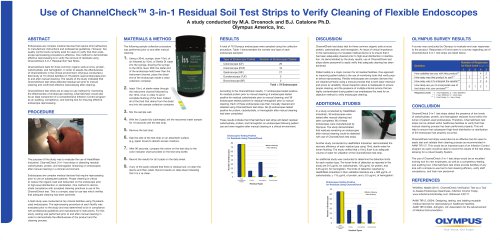
Tips, Tricks and Insights for Implementation and Management of an Endoscope Sampling and Culturing Program
1 /
13Páginas
Excertos do catálogo
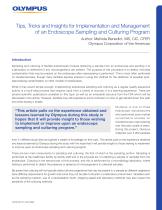
Tips, Tricks and Insights for Implementation and Management of an Endoscope Sampling and Culturing Program Author: Melinda Benedict, MS, CIC, CFER Olympus Corporation of the Americas Introduction Sampling and culturing of flexible endoscopes involves obtaining a sample from an endoscope and sending it to a laboratory to determine if any microorganisms are present. The purpose of this procedure is to detect microbial contamination that may be present on the endoscope after reprocessing is performed.1 This is most often performed on duodenoscopes, though many facilities express interest in using this method for the detection of possible postreprocessing contamination on other models of endoscopes. While it may sound simple enough, implementing endoscope sampling and culturing as a regular quality assurance activity is a multi-step process that requires input from a variety of sources; it is a learning experience. There are several scientific publications available on this topic as well as an invaluable resource from the FDA which will be discussed in this article. However, facilities may still experience some confusion on how to get started down this path and what exactly it entails. “This article pulls on the experience obtained and lessons learned by Olympus during this study in hopes that it will provide insight to those wishing to implement or improve upon an endoscope sampling and culturing program.” O l y m p u s i s o n e o f t h re e endoscope manufacturers who performed post-market surveillance studies on duodenoscope reprocessing over the past couple of years. During this project, Olympus collected over 2,000 samples from 21 different study sites and gained a wealth of knowledge on this topic. This article pulls on the experience obtained and lessons learned by Olympus during this study with the hope that it will provide insight to those wishing to implement or improve upon an endoscope sampling and culturing program. There are two main components to sampling and culturing, the first of which is the sampling portion. Sampling is performed at the healthcare facility by facility staff and is the physical act of collecting a sample or samples from the endoscope. Culturing is the second part of this process, and this is performed by a microbiology laboratory, where testing is performed to detect the presence or absence of microorganisms in collected samples. Be aware that culturing will not typically detect all microorganisms that may be present in a sample as different organisms have differing requirements for growth and some may not be able to flourish in a laboratory environment. Variables such as the sampling medium, use of a neutralization broth, shipping speed and laboratory methods may also impact the sensitivity of the culturing methods. Continued on next page
Abrir o catálogo na página 1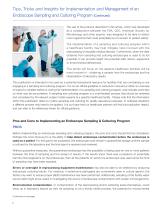
Tips, Tricks and Insights for Implementation and Management of an Endoscope Sampling and Culturing Program (Continued) The use of the protocol described in this article, which was developed as a collaboration between the FDA, CDC, American Society for Microbiology and other experts, was designed to be able to detect most organisms that could potentially be of concern to patient safety.1 The implementation of a sampling and culturing program within a healthcare facility may help mitigate risks involved with the reprocessing of reusable medical devices. Furthermore, when the data obtained...
Abrir o catálogo na página 2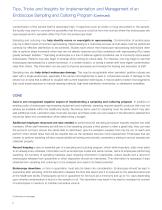
Tips, Tricks and Insights for Implementation and Management of an Endoscope Sampling and Culturing Program (Continued) contamination of the sample itself is reasonably high. If organisms such as molds or fungi are present in the sample, the facility may want to consider the possibility that the source could be from the room(s) where the endoscopes are reprocessed and/or sampled rather than from the endoscope itself. Sampling and culturing may help identify errors or oversights in reprocessing. Contamination of endoscopes may be a direct result of incorrect reprocessing. Reprocessing is a...
Abrir o catálogo na página 3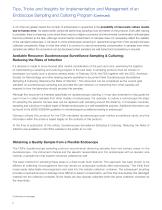
Tips, Tricks and Insights for Implementation and Management of an Endoscope Sampling and Culturing Program (Continued) A con that can greatly impact the number of endoscopes in quarantine is the possibility of inaccurate culture results due to human error. As stated earlier, personnel performing sampling must be trained on the protocol. Even after training is complete, there is a learning curve where there may be a higher occurrence of environmental contamination until samplers become proficient at the task. Although environmental contamination of samples does not necessarily reflect the...
Abrir o catálogo na página 4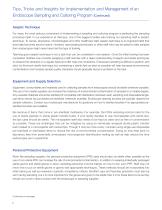
Tips, Tricks and Insights for Implementation and Management of an Endoscope Sampling and Culturing Program (Continued) Aseptic Technique For many, the most arduous component of implementing a sampling and culturing program is perfecting the sampling procedure itself. In our experience at Olympus, one of the biggest hurdles was training our sampling staff in aseptic technique. To nurses, physicians, microbiologists and other healthcare staff, aseptic technique is an ingrained habit that eventually becomes second nature. However, reprocessing technicians or other staff who may be asked to...
Abrir o catálogo na página 5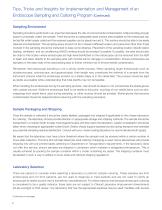
Tips, Tricks and Insights for Implementation and Management of an Endoscope Sampling and Culturing Program (Continued) Sampling Environment Sampling should be performed in an area that decreases the risk of environmental contamination while providing enough space to physically collect the sample. There should be an adequately sized surface area available so the endoscope can be laid flat while loosely coiled and the required supplies can be placed around it. This surface should be able to be easily cleaned and disinfected. The sampling space should not be in heavily trafficked location and...
Abrir o catálogo na página 6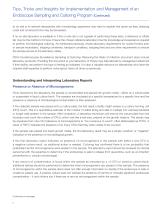
Tips, Tricks and Insights for Implementation and Management of an Endoscope Sampling and Culturing Program (Continued) to on-site or in-network laboratories with microbiology experience may want to explore this option as fees, shipping costs and turnaround time may be decreased. If no on-site laboratory is available or if the on-site lab is not capable of performing these tests, a reference or offsite lab may be the method of choice. Ensure the chosen reference laboratory has the knowledge and experience required to perform microbiological culturing. As mentioned previously, review...
Abrir o catálogo na página 7Todos os catálogos e folhetos técnicos Olympus America
-
Olympus Endo Capsule Update
2 Páginas
-
EasySuite® 4K
8 Páginas
-
CF-HQ190L/I
2 Páginas
-
GIF-1TH190
2 Páginas
-
GIF-H190
2 Páginas
-
GIF-HQ190
2 Páginas
-
MAJ-2022
2 Páginas
-
Rigid ENT HD Sinuscopes
3 Páginas
-
HD Endoeye
4 Páginas
-
ENT Family brochure
12 Páginas
-
BF-1T260
2 Páginas
Catálogos arquivados
-
ALT-Pro
2 Páginas
-
V-System Family Brochure
10 Páginas
-
HiQ Series
13 Páginas
-
BF-1TQ180
2 Páginas
-
BF-Q180
3 Páginas
-
CF-HQ190L
2 Páginas
-
PCF-H190LI
2 Páginas
-
PCF-PH190LI
2 Páginas
-
TJF-Q180V
2 Páginas
-
GIF-XP190N
2 Páginas
-
EC-1
7 Páginas
-
CF-Q165I/L
2 Páginas
-
CF-H190
3 Páginas
-
BF-XT160
2 Páginas
-
BF-UC180F
2 Páginas
-
EVIS EXERA III
7 Páginas
-
BF-PE2
3 Páginas
-
BF-P180
2 Páginas
-
BF-N20
2 Páginas
-
BF-MP60
2 Páginas
-
BF-MP160F
4 Páginas
-
BF-H190
2 Páginas
-
BF-1TH190
7 Páginas
-
BF-1T180
2 Páginas
-
GIF-H260
3 Páginas
-
GIF-FQ260Z
3 Páginas
-
BF-F260
4 Páginas
-
magazine (2008)
48 Páginas




